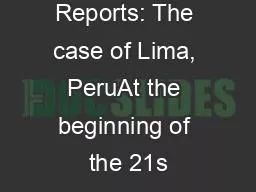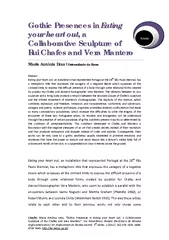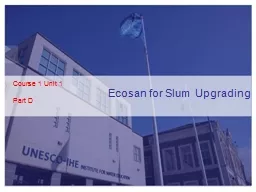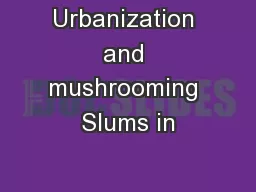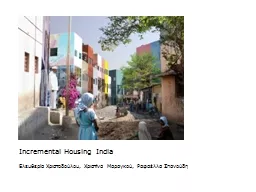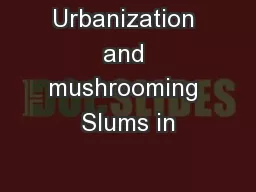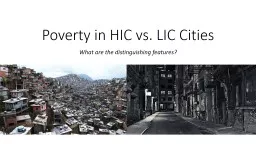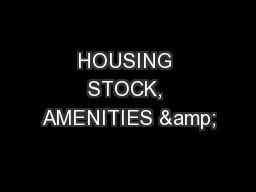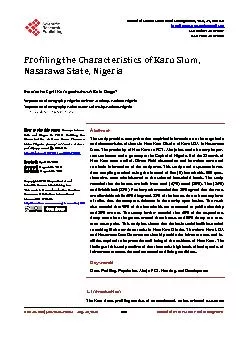PDF-Urban Slums Reports: The case of Lima, PeruAt the beginning of the 21s
Author : bikershobbit | Published Date : 2020-11-19
Table 2 Peru Growth Rate Period Source INEI 2002 POPULATION ANNUALINTERCENSAL GROWTH RATE 1993 Metropolitan AREQUIPA Table 3 Lima Growth Rates 2 3 UNDERSTANDING
Presentation Embed Code
Download Presentation
Download Presentation The PPT/PDF document "Urban Slums Reports: The case of Lima, P..." is the property of its rightful owner. Permission is granted to download and print the materials on this website for personal, non-commercial use only, and to display it on your personal computer provided you do not modify the materials and that you retain all copyright notices contained in the materials. By downloading content from our website, you accept the terms of this agreement.
Urban Slums Reports: The case of Lima, PeruAt the beginning of the 21s: Transcript
Table 2 Peru Growth Rate Period Source INEI 2002 POPULATION ANNUALINTERCENSAL GROWTH RATE 1993 Metropolitan AREQUIPA Table 3 Lima Growth Rates 2 3 UNDERSTANDING SLUMSCase Studies for the Global. brPage 1br niversidad de Lima Escuela Universitaria de Ingeniera Facultad de Ingeniera Industrial Trabajo profesional para optar el Ttulo Profesional en Ingeniera Industrial Proyecto para mejora brPage 1br Beginning Tutorials brPage 2br Beginning Tutorials brPage 3br Beginning Tutorials brPage 4br Beginning Tutorials brPage 5br Beginning Tutorials brPage 6br brPage 1br Maria Antnia Lima Universidade de vora brPage 2br Maria Antnia Lima Via Panormica 3rd Series 1 2012 Ensaio 163 brPage 3br Maria Antnia Lima Via Panormica 3rd Series 1 Course 1 Unit . 1. Part D. 1. Slums world wide. There are about 1 billion slum . dwellers; by 2020 this number is expected to have extended to 1.4 billion. (2. ). What is a slum?. There . is no internationally accepted definition of . The feast of corpus . christi. The festival of Corpus Christi has been celebrated all over Peru since colonial . times. . Sixty . days after Easter Sunday, the members of each nearby church bear their patron saint in a procession to the chimes of the . Paksitan. Population: 170 million. Number of people in slums: 26.6 million. Percentage of urban population in slums: 48%. Partner organisation: Orangi Pilot Project (OPP). Pakistan, ranked 141 of 182 in the United Nation’s Human Poverty Index, faces complex development challenges and is characterised by major inequalities in income and access to basic services. A high proportion of people in Pakistan live in slums and the country is facing rapid, sustained slum growth rates. Urgent action is required to slow down or reverse these trends. A significant proportion of Pakistan’s population lack access to basic infrastructure (90% of the population has access to improved water, and only 45% to improved sanitation), suffer from ill health and illiteracy, with 60% living on less than two US dollars a day. Ελευθερία Χριστοδούλου, Χριστίνα Μαραγκού, Ραφαέλλα Σπανούδη. Place located:. . Yerawada. slum, . Pune. city, Bombay India. 4000 families . Organizations involved :. Paksitan. Population: 170 million. Number of people in slums: 26.6 million. Percentage of urban population in slums: 48%. Partner organisation: Orangi Pilot Project (OPP). Pakistan, ranked 141 of 182 in the United Nation’s Human Poverty Index, faces complex development challenges and is characterised by major inequalities in income and access to basic services. A high proportion of people in Pakistan live in slums and the country is facing rapid, sustained slum growth rates. Urgent action is required to slow down or reverse these trends. A significant proportion of Pakistan’s population lack access to basic infrastructure (90% of the population has access to improved water, and only 45% to improved sanitation), suffer from ill health and illiteracy, with 60% living on less than two US dollars a day. What are the distinguishing features?. New York . Rio De Janeiro . Low Income Countries:. Slums, Shantytowns, Favelas. Filled with people from countryside . (due to urban-rural migration). Remember, average line of latitude for . ASSETS IN SLUMS - CENSUS 2011. Dr C. CHANDRAMOULI. REGISTRAR GENERAL & CENSUS COMMISSIONER, INDIA. A Slum in Delhi. Definition of a Slum. A Slum, for the purpose of Census, has been defined as residential areas where dwellings are unfit for human habitation by reasons of dilapidation, overcrowding, faulty arrangements and design of such buildings, narrowness or faulty arrangement of street, lack of ventilation, light, or sanitation facilities or any combination of these factors which are detrimental to the safety and health. . b. aufällige . und schmutzige Häuser/Hütten. k. eine . Sanitäreinrichtungen. k. ein . Strom. v. erunreinigtes . Trinkwasser. h. ohe . Kriminalität. . Impressum. © Österreichischer Bundesverlag Schulbuch GmbH & Co. KG, Wien 2015. ISSN Online: 1940ISSN Print: DOI: 10.4236/jssm.2019.125041Aug., 201Journal of Service Science and Management Profiling the Characteristics of Karu Slum, Nasarawa StateNigeria Abstract The study prov Lima Bean FactsLima beans are large flat kidney-shaped edible seeds in the bean family The seeds are generally cream or light green in color although certain varieties feature colors such as white pur Autores:. Carlos Gustavo Leite Vieira. Nádia . Carolina Lima e . Lima. Vinicius . Carriero. Lima. Purpose. To. . present. a case . of. laser . treatment. in . Coats. . disease. in a . female.
Download Document
Here is the link to download the presentation.
"Urban Slums Reports: The case of Lima, PeruAt the beginning of the 21s"The content belongs to its owner. You may download and print it for personal use, without modification, and keep all copyright notices. By downloading, you agree to these terms.
Related Documents

